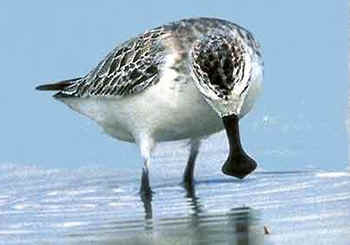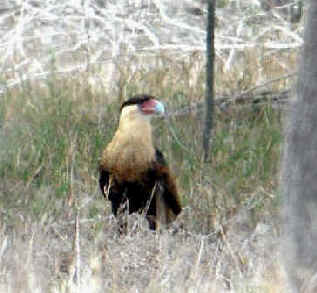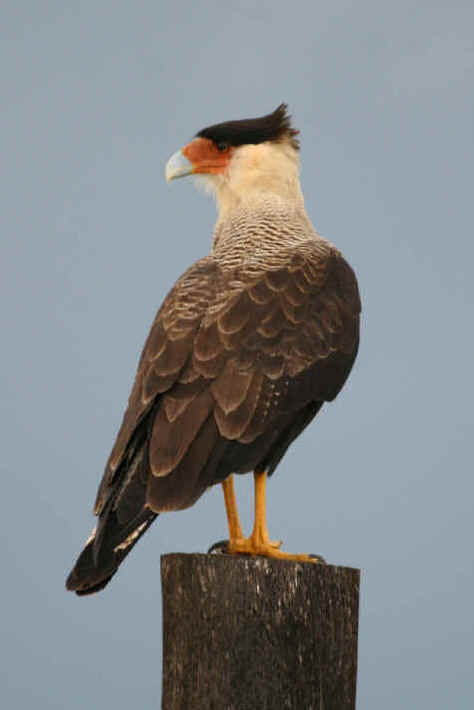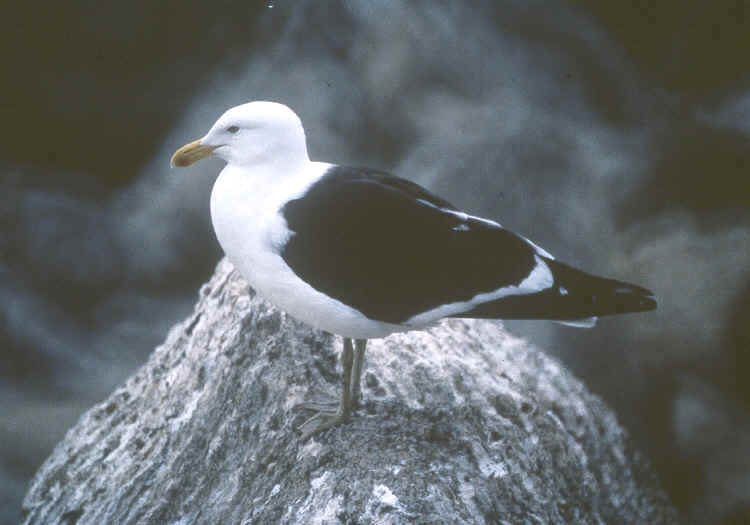The
Birdline & Natureline for September 13, 2012:
Those of us who have
been birding for a while have thought about CARACARAS (if we
thought about CARACARAS) as usually being rather sedentary birds
where they occur in North America, in Texas &
Florida.
In the "National Geographic Field Guide to the Birds of North
America 5th Edition", published in 2006, it is said
about the CRESTED (now NORTHERN CRESTED) CARACARA: Records from
well outside the normal range are of "debatable origin".
In the "Lives of North American Birds", by Kenn
Kaufman, published in 1996, it is written: "Adults are
typically permanent residents on territory. Young birds may wander
considerable distances."
But as far north as James Bay in northern Ontario? That's where
one was for 10 days in July 2002. A TURKEY VULTURE has never even been
seen that far north.
And that was the third record for Ontario.
Others were in July 1892, on a remote island in Lake Superior -
that bird found dead after a storm.
And another July 1994 on Pelee Island (that's not Point Pelee) in
Essex County, Ontario.
A couple weeks ago, another NORTHERN CRESTED CARACARA (living up
to its new name) was reported in Canada in Quebec.
And more recently, this past week, a NORTHERN CRESTED CARACARA has
been in the northeastern US, in New Jersey, about 10
miles northeast of Trenton, in West Windsor Township. It was
discovered at a farm there on September 8, and has continued at
times each day since.
Actually, CARACARAS have been noted in New Jersey twice
previously:
one in Middlesex County in 1976, almost certainly an escaped bird,
and
one at Sandy Hook in 2007, that was said possibly to have
been of "wild provenance".
One (the same?) was seen further north in Massachusetts in
2007 - that was the 2nd time in that state.
There was a CRESTED CARACARA sighting in Indiana in June 2011.
In the western United States, it seems that during the last
decade, the CARACARA has had a fairly strong pattern of
vagrancy, with records in South Dakota, Montana, Idaho,
Washington State, Oregon, Nevada, Colorado, and several in
California.
There's been at least one occurrence in British Colombia,
Canada.
In addition to the places already mentioned, records for CARACARAS
have also been accepted, or are currently being considered
in: Alabama (2), Georgia (1), Iowa (1), Minnesota (1),
Mississippi
(2), and New Brunswick, Canada (1).
By the way, generally speaking, the SOUTHERN CARACARA occurs in
South America, south of the Amazon.
The NORTHERN CRESTED
CARACARA occurs generally north from the Amazon in
South America, Central America, and into the
United States,
and yes, now, on occasion, into Canada.
The SOUTHERN CARACARA could also be called the SOUTHERN CRESTED
CARACARA. The SOUTHERN CARACARA is not the most southern of
CARACARAS. The STRIATED CARACARA occurs at Cape Horn.
Not long ago, on August 28, another bird species normally in the
far-southwest US & in Mexico, and not normally further
north, appeared in Canada, a THICK-BILLED KINGBIRD at the
Presqui'ile Provincial Park, near Brighton, Ontario.
The bird was photographed and it would be not only a
first provincial record for Ontario, but a first for eastern North
America, and the second record for Canada.
Another bird of the southwestern US & the Midwest, has appeared
this week in eastern North America, a BELL'S VIREO in
New York City, on Staten Island, at Mount Loretto. Seen September
11 &12, at least, it is a 3rd record for the species in New
York State although there have been more sightings of it in recent
years in the East, in New Jersey and Maryland among other
places.
Probably the city in North America where the most species of GULLS
have been found is Chicago, where at Montrose Harbor, on one
occasion or another, these species have occurred (not in any
particular order):
LAUGHING, FRANKLIN'S, LITTLE, ROSS', BLACK-HEADED,
BONAPARTE'S, MEW, RING-BILLED, CALIFORNIA, HERRING, THAYER'S,
ICELAND, GLAUCOUS, LESSER BLACK-BACKED, GREAT BLACK-BACKED,
SABINE'S, IVORY, BLACK-TAILED, and the BLACK-LEGGED KITTIWAKE.
That's 19 species of GULLS.
But watch out Chicago for Wheatley Harbor, Ontario, where this
past week, on September 7, a KELP GULL was found - the 18th GULL
SPECIES for that location by Lake Erie, just east of Point Pelee.
This September 2012 KELP GULL is, like the forementioned KINGBIRD,
a first for Ontario. However, it is also a first for Canada.
Regarding the KELP GULL, the first in North America was back in
1989, when a bird was found on the Chandeleur Islands in Louisiana. In 1990, the species was found to be breeding there.
By 2004, all of the dark-mantled gulls on Chandeleur Island were
either hybrids or backcrosses with HERRING GULLS.
Elsewhere in North America, there have been KELP GULLS in Indiana
in 1996, in Colorado in 2003, in Florida in 2011, in
Texas in
1996, 1997, & 2008, and in Maryland where there was one
individual from 1998 to 2005 known as "Shrimpy".
Referring again to the Chandeleur Islands in Louisiana, that
area was hit hard by Hurricane Katrina in 2005, and since then
KELP GULL occurrences in North America have been very few.
More recently, with Hurricane Isaac, a GREAT SHEARWATER
appeared in Michigan, in Benzie County, on Lake Michigan by the
mouth of the Platte River. Seen on September 8, it appeared weak.
The following morning, that first GREAT SHEARWATER ever in
Michigan, was found dead. The specimen was donated to the
University of Michigan.
Other GREAT SHEARWATERS, resulting from Isaac, were
found in Bowie County, Texas and in Livingston County,
Kentucky.
A juvenile SABINE'S GULL was seen this past week in Rhode
Island,
observed resting on rocks at the end of Napatree Point, before it
flew away.
An adult SABINE'S GULL was in Virginia on September 6 at a
wastewater plant near Mt. Crawford.
In Maryland, maybe it was the same bird from September 8 to 10 at
the Tridelphia Reservoir in Howard County.
A single, but very vocal RED CROSSBILL was in pines at the
Coatesville Reservoir in Chester County, Pennsylvania on September
9.
In New Hampshire, that day, September 9, a MISSISSIPPI KITE
was still in Newmarket.
That day, September 9, in New Jersey, there a one-day record
for BALD EAGLES at the Chimney Rock hawk watch in
Martinsville, when 32 were counted.
The next day, September 10, at Hawk Mountain in Pennsylvania,
2,806 MONARCH BUTTERFLIES were counted, the most ever counted
there in a single day.
On September 11, in Lancaster County, Pennsylvania, a birder
having supper had the very good fortune to see a lifer outside her
window. Her first GOLDEN-WINGED WARBLER, a male. Nice, and
exciting.
An most unusual bird in Lancaster County PA was seen, and
confirmed by a photograph, on September 5 - a single PIPING
PLOVER, with some other migrating shorebirds, on an island in the
Susequehanna River at the place called the Conejohela Flats.
PIPING PLOVERS are rarely seen seen in Pennsylvania away from
the shore of Lake Erie (and there they are certainly not common).
In Lancaster County, from 1950 to 1970, there were only 6
PIPING PLOVER sightings. From 1970 to the present, there have only
been 2 sightings: 1 in 2000, and 1 in 2002.
So, yes, the PIPING PLOVER is a most unusual bird in Lancaster
County, PA.
Let's go, for our last report, from a river island in
Pennsylvania to an island on the other side of the world in South
Korea:
This week, on Tuesday, September 11, in a report presented to a
global conservation forum on Jeju Island, in South Korea, the
International Union for Conservation of Nature, and the Zoological Society
of London, unveiled a list of the world's 100 most threatened
animals, plants, and fungi, noting that urgent action is
needed to save them.
Among the BIRDS in that list is the SPOON-BILLED SANDPIPER of
eastern Asia.
It is said that bird is perhaps hurtling toward extinction faster
than any bird on Earth, with now probably fewer than 100 pairs
remaining. Its population is in "free fall" and
without that "urgent action that is needed", it could be
gone within a decade.

The Spoon-billed
Sandpiper
Another time here, we'll have more about the 100 threatened
creatures and more about that particular bird, the SPOON-BILLED
SANDPIPER, and maybe some day in the future (if I can be
optimistic), some good news about it!
Now, some good news I can say is that in the Focus On Nature Tours
website, we have reached a plateau of photographs of 1,600
different creatures among the nature in this world that
we're lucky to have.
And among the photos are those of just over 1,000 species of
birds. Also, mammals, amphibians, reptiles, butterflies, moths,
dragonflies and more.
A sincere thank you to everyone who have has contributed
photographs to our collection.
Not only do they show what has been and can be seen and
experienced during tours, but also people at home and students at
school can see what nature there is out there, either close
to home, or further away.
A number of school teachers have expressed to us their
appreciation that children have been able to see the
photos, and thus learn about the various types of creatures
just noted, from small moths and beautiful butterflies, to big
animals and colorful birds.
If you'd like to take a look, please scroll down the left-side of
the home-page in the link below:
www.focusonnature.com
The Birdline (and the Natureline) are affiliates of Focus On
Nature Tours.
Armas Hill has presented the Birdline, originally from
Philadelphia, on the phone and internet for over 3 decades, and on
the radio in Delaware for 10 years.





